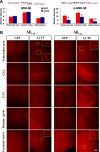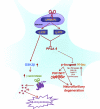The carboxy-terminal fragment of inhibitor-2 of protein phosphatase-2A induces Alzheimer disease pathology and cognitive impairment
- PMID: 20651003
- PMCID: PMC3229424
- DOI: 10.1096/fj.10-158477
The carboxy-terminal fragment of inhibitor-2 of protein phosphatase-2A induces Alzheimer disease pathology and cognitive impairment
Abstract
Development of rational therapeutic treatments of Alzheimer disease (AD) requires the elucidation of the etiopathogenic mechanisms of neurofibrillary degeneration and β-amyloidosis, the two hallmarks of this disease. Here we show, employing an adeno-associated virus serotype 1 (AAV1)-induced expression of the C-terminal fragment (I(2CTF)) of I(2)(PP2A), also called SET, in rat brain, decrease in protein phosphatase 2A (PP2A) activity, abnormal hyperphosphorylation of tau, and neurodegeneration; littermates treated identically but with vector only, i.e., AAV1-enhanced green fluorescent protein (GFP), served as a control. Furthermore, there was an increase in the level of activated glycogen synthase kinase-3β and enhanced expression of intraneuronal Aβ in AAV1-I(2CTF) animals. Morris water maze behavioral test revealed that infection with AAV1-I(2CTF) induced spatial reference memory and memory consolidation deficits and a decrease in the brain level of pSer133-CREB. These findings suggest a novel etiopathogenic mechanism of AD, which is initiated by the cleavage of I(2)(PP2A), producing I(2CTF), and describe a novel disease-relevant nontransgenic animal model of AD.
Figures








Similar articles
-
Inhibition of Protein Phosphatase-2A (PP2A) by I1PP2A Leads to Hyperphosphorylation of Tau, Neurodegeneration, and Cognitive Impairment in Rats.J Alzheimers Dis. 2015;45(2):423-35. doi: 10.3233/JAD-142403. J Alzheimers Dis. 2015. PMID: 25589718
-
Alzheimer disease and amyotrophic lateral sclerosis: an etiopathogenic connection.Acta Neuropathol. 2014 Feb;127(2):243-56. doi: 10.1007/s00401-013-1175-9. Epub 2013 Oct 18. Acta Neuropathol. 2014. PMID: 24136402 Free PMC article.
-
Cytoplasmic retention of protein phosphatase 2A inhibitor 2 (I2PP2A) induces Alzheimer-like abnormal hyperphosphorylation of Tau.J Biol Chem. 2014 Oct 3;289(40):27677-91. doi: 10.1074/jbc.M114.565358. Epub 2014 Aug 15. J Biol Chem. 2014. PMID: 25128526 Free PMC article.
-
Alzheimer's disease neurofibrillary degeneration: pivotal and multifactorial.Biochem Soc Trans. 2010 Aug;38(4):962-6. doi: 10.1042/BST0380962. Biochem Soc Trans. 2010. PMID: 20658985 Free PMC article. Review.
-
Targeting of PP2 A/GSK3β/PTEN Axis in Alzheimer Disease: The Mooting Evidence, Divine, and Devil.Cell Mol Neurobiol. 2025 Apr 18;45(1):36. doi: 10.1007/s10571-025-01554-0. Cell Mol Neurobiol. 2025. PMID: 40251348 Free PMC article. Review.
Cited by
-
Memantine Attenuates Alzheimer's Disease-Like Pathology and Cognitive Impairment.PLoS One. 2015 Dec 23;10(12):e0145441. doi: 10.1371/journal.pone.0145441. eCollection 2015. PLoS One. 2015. PMID: 26697860 Free PMC article.
-
Leucine Carboxyl Methyltransferase 1 Overexpression Protects Against Cognitive and Electrophysiological Impairments in Tg2576 APP Transgenic Mice.J Alzheimers Dis. 2021;79(4):1813-1829. doi: 10.3233/JAD-200462. J Alzheimers Dis. 2021. PMID: 33459709 Free PMC article.
-
The next decade of SET: from an oncoprotein to beyond.J Mol Cell Biol. 2024 Jul 1;16(1):mjad082. doi: 10.1093/jmcb/mjad082. J Mol Cell Biol. 2024. PMID: 38157418 Free PMC article. Review.
-
Glycogen synthase kinase-3 inhibitors: Rescuers of cognitive impairments.Pharmacol Ther. 2014 Jan;141(1):1-12. doi: 10.1016/j.pharmthera.2013.07.010. Epub 2013 Jul 31. Pharmacol Ther. 2014. PMID: 23916593 Free PMC article. Review.
-
Silencing PP2A inhibitor by lenti-shRNA interference ameliorates neuropathologies and memory deficits in tg2576 mice.Mol Ther. 2013 Dec;21(12):2247-57. doi: 10.1038/mt.2013.189. Epub 2013 Aug 7. Mol Ther. 2013. PMID: 23922015 Free PMC article.
References
-
- Iqbal K., Flory M., Khatoon S., Soininen H., Pirttila T., Lehtovirta M., Alafuzoff I., Blennow K., Andreasen N., Vanmechelen E., Grundke-Iqbal I. (2005) Subgroups of Alzheimer's disease based on cerebrospinal fluid molecular markers. Ann. Neurol. 58, 748– 757 - PubMed
-
- Alafuzoff I., Iqbal K., Friden H., Adolfsson R., Winblad B. (1987) Histopathological criteria for progressive dementia disorders: clinical-pathological correlation and classification by multivariate data analysis. Acta Neuropathol. (Berl.). 74, 209– 225 - PubMed
-
- Grundke-Iqbal I., Iqbal K., Quinlan M., Tung Y. C., Zaidi M. S., Wisniewski H. M. (1986) Microtubule-associated protein tau. A component of Alzheimer paired helical filaments. J. Biol. Chem. 261, 6084– 6089 - PubMed
-
- Bennecib M., Gong C. X., Grundke-Iqbal I., Iqbal K. (2000) Role of protein phosphatase-2A and -1 in the regulation of GSK-3, cdk5 and cdc2 and the phosphorylation of tau in rat forebrain. FEBS Lett. 485, 87– 93 - PubMed
Publication types
MeSH terms
Substances
Grants and funding
LinkOut - more resources
Full Text Sources
Other Literature Sources
Medical
Molecular Biology Databases
Miscellaneous

